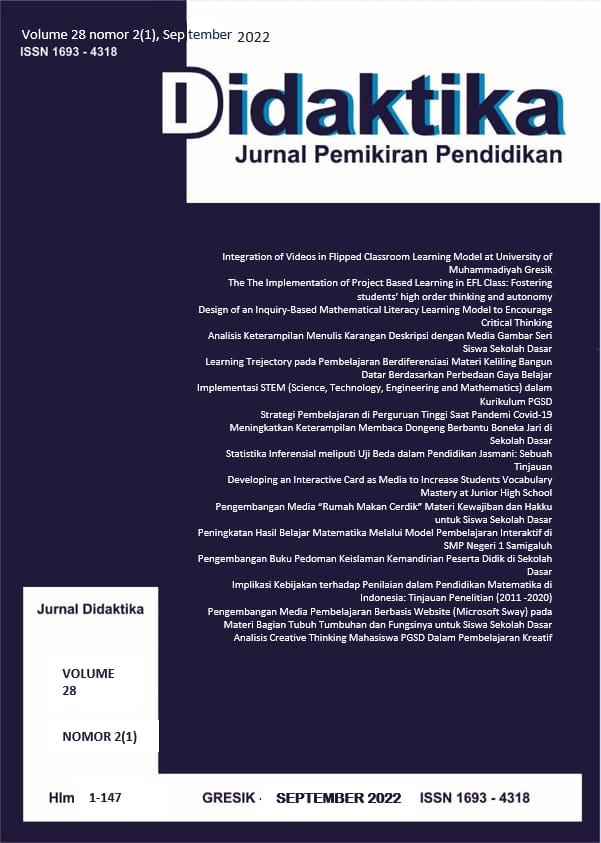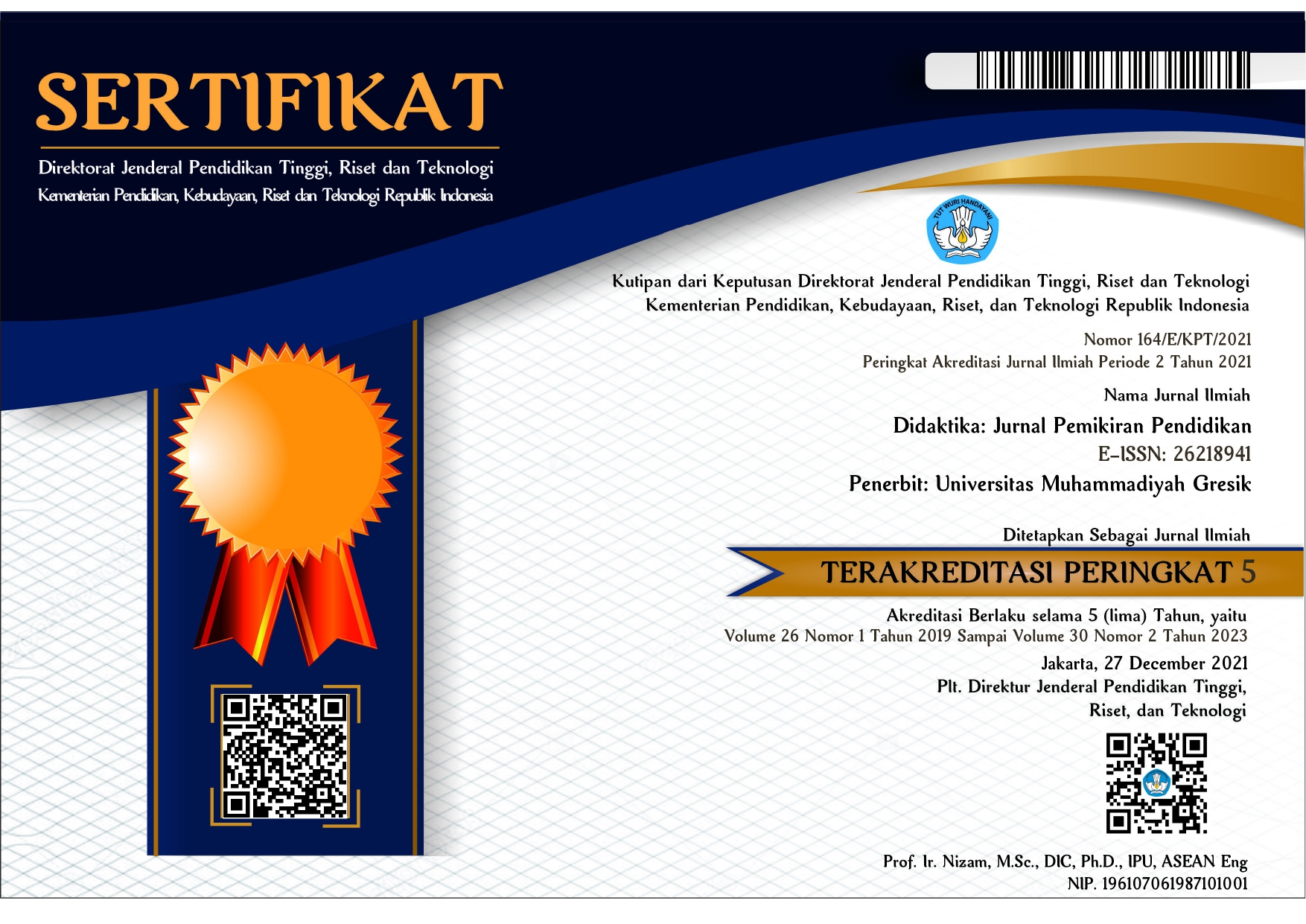Analisis Keterampilan Menulis Karangan Deskripsi dengan Media Gambar Seri Siswa Sekolah Dasar
DOI:
https://doi.org/10.30587/didaktika.v28i2.4377Keywords:
Keterampilan Menulis; Karangan Deskripsi; Gambar SeriAbstract
Penelitian ini bertujuan untuk mengetahui hasil dan kesulitan yang dihadapi siswa kelas III dalam keterampilan menulis karangan deskripsi menggunakan media gambar seri di UPT SD Negeri 119 Gresik. Untuk metode analisis data menggunakan dekriptif kualitatif sedangkan teknik pengumpulan datanya melalui observasi, lembar tes keterampilan menulis karangan deskripsi, wawancara dan dokumentasi. Berdasarkan hasil penelitian, rata-rata nilai keterampilan menulis karangan deskripsi siswa yaitu 78,8 dengan kategori baik. Hal ini ditunjukkan dengan banyaknya 14 siswa yang sudah mampu mencapai nilai KKM yang telah ditentukan. Untuk kesulitan yang dihadapi siswa yaitu (a) siswa masih binggung dalam memulai menulis sebuah karangan (b) kesulitan merangkai kata menjadi sebuah kalimat yang saling berkaitan dan (c) masih ada siswa yang belum bisa membaca
References
Ayu, Kurniasih, & Mulyasari. (2019). Penerapan Pendekatan Ctl Untuk. JURNAL PENDIDIKAN GURU SEKOLAH DASAR MENINGKATKAN KETERAMPILAN MENULIS KARANGAN DESKRIPSI PADA SISWA KELAS V SD, 4(Iii).
Godvany, N., Nurjaya, I. G., & Gunatama, G. (2017). MENINGKATKAN KETERAMPILAN MENULIS KARANGAN DESKRIPSI MELALUI KEGIATAN BELAJAR DI LUAR KELAS DENGAN PENDEKATAN KONTEKSTUAL PADA SISWA KELAS VII SMP NEGERI 1 SUKASADA. Universitas Pendidikan Ganesha, 6(1).
Hartati, & Idrus. (2018). DIKSI PADA KARANGAN NARASI SISWA KELAS VIII C MTs. ALKHAIRAAT KALUKUBULA. Guru Tua : Jurnal Pendidikan Dan Pembelajaran, 1(1). https://doi.org/10.31970/gurutua.v1i1.12
Idarliati. (2018). Peningkatan Keterampilan Menulis Karangan Deskripsi Dengan Menggunakan Media Gambar. Pedagogik Journal of Islamic Elementary School, 1(1).
Inggriyani, F., & Pebrianti, N. A. (2021). Analisis Kesulitan Keterampilan Menulis Karangan Deskripsi Peserta Didik Di Sekolah Dasar. Didaktik : Jurnal Ilmiah PGSD STKIP Subang, 7(01).
Khair, U. (2018). Pembelajaran Bahasa Indonesia dan Sastra (BASASTRA) di SD dan MI. AR-RIAYAH: Jurnal Pendidikan Dasar, 2(1).
Kholisah, I., Indihadi, D., & Karlimah. (2020). PEDADIDAKTIKA: Jurnal Ilmiah Pendidikan Guru Sekolah Dasar. Jurnal Ilmiah, 7(4).
Khulsum, U., Hudiyono, Y., & Sulistyowati, E. D. (2018). Pengembangan Bahan Ajar Menulis Cerpen Dengan Media Storyboard Pada Siswa Kelas X Sma. DIGLOSIA : Jurnal Kajian Bahasa, Sastra, Dan Pengajarannya, 1(1).
Munawaroh, F. H., Janah, U. I. W., Suparno, A. D., & Niswa, B. (2021). MODEL DAN MEDIA PEMBELAJARAN BAHASA INDONESIA SD. Scopindo Media Pustaka.
Nofitri, Z., & Noveria, E. (2020). Hubungan Kemampuan Membaca Pemahaman dengan Kemampuan Menulis. Pendidikan Bahasa Indonesia, 9(3). https://doi.org/10.24036/108994-019883
Purwanti, T. (2018). Peningkatan Keterampilan Menulis Paragraf Deskripsi Menggunakan Media Kartu Gambar Pada Siswa Kelas Iv Sd Negeri 2 Geneng Jepara. Jurnal Pendidikan Bahasa Indonesia, 5(2).
Rodiyah. (2019). Penggunaan Media Gambar Seri Untuk Meningkatkan Keterampilan Menulis Kalimat Sederhana Siswa Kelas Ii Sekolah Dasar. Jurnal Inovasi Pembelajaran Karakter (JIPK), 4(3).
Utami, K., Oktaviany, V., & Dwiprabowo, R. (2021). Hubungan Minat Membaca Dengan Keterampilan Menulis Narasi. Prosiding Seminar Nasional Pendidikan STKIP Kusuma Negara 2021.
Zubaidi, A., & Faznur, L. S. (2019). Analisis kesalahan ejaan bahasa indonesia pada karangan narasi mahasiswa thailand di universitas muhammadiyah jakarta. Seminar Nasional Pendidikan, 126–132.
Downloads
Published
How to Cite
Issue
Section
License
License and Copyright Agreement
In submitting the manuscript to the journal, the authors certify that:
- They are authorized by their co-authors to enter into these arrangements.
- The work described has not been formally published before, except in the form of an abstract or as part of a published lecture, review, thesis, or overlay journal.
- That it is not under consideration for publication elsewhere,
- That its publication has been approved by all the author(s) and by the responsible authorities – tacitly or explicitly – of the institutes where the work has been carried out.
- They secure the right to reproduce any material that has already been published or copyrighted elsewhere.
- They agree to the following license and copyright agreement.
Copyright
Authors who publish with DIDAKTIKA: Jurnal Pemikiran Pendidikan agree to the following terms:
- Authors retain copyright and grant the journal right of first publication with the work simultaneously licensed under a Creative Commons Attribution License (CC BY-SA 4.0) that allows others to share the work with an acknowledgment of the work's authorship and initial publication in this journal.
- Authors are able to enter into separate, additional contractual arrangements for the non-exclusive distribution of the journal's published version of the work (e.g., post it to an institutional repository or publish it in a book), with an acknowledgment of its initial publication in this journal.
- Authors are permitted and encouraged to post their work online (e.g., in institutional repositories or on their website) prior to and during the submission process, as it can lead to productive exchanges, as well as earlier and greater citation of published work.
Licensing for Data Publication
Open Data and Software Publishing and Sharing
The journal strives to maximize the replicability of the research published in it. Authors are thus required to share all data, code or protocols underlying the research reported in their articles. Exceptions are permitted but have to be justified in a written public statement accompanying the article.
Datasets and software should be deposited and permanently archived inappropriate, trusted, general, or domain-specific repositories (please consult http://service.re3data.org and/or software repositories such as GitHub, GitLab, Bioinformatics.org, or equivalent). The associated persistent identifiers (e.g. DOI, or others) of the dataset(s) must be included in the data or software resources section of the article. Reference(s) to datasets and software should also be included in the reference list of the article with DOIs (where available). Where no domain-specific data repository exists, authors should deposit their datasets in a general repository such as ZENODO, Dryad, Dataverse, or others.
Small data may also be published as data files or packages supplementary to a research article, however, the authors should prefer in all cases a deposition in data repositories.











